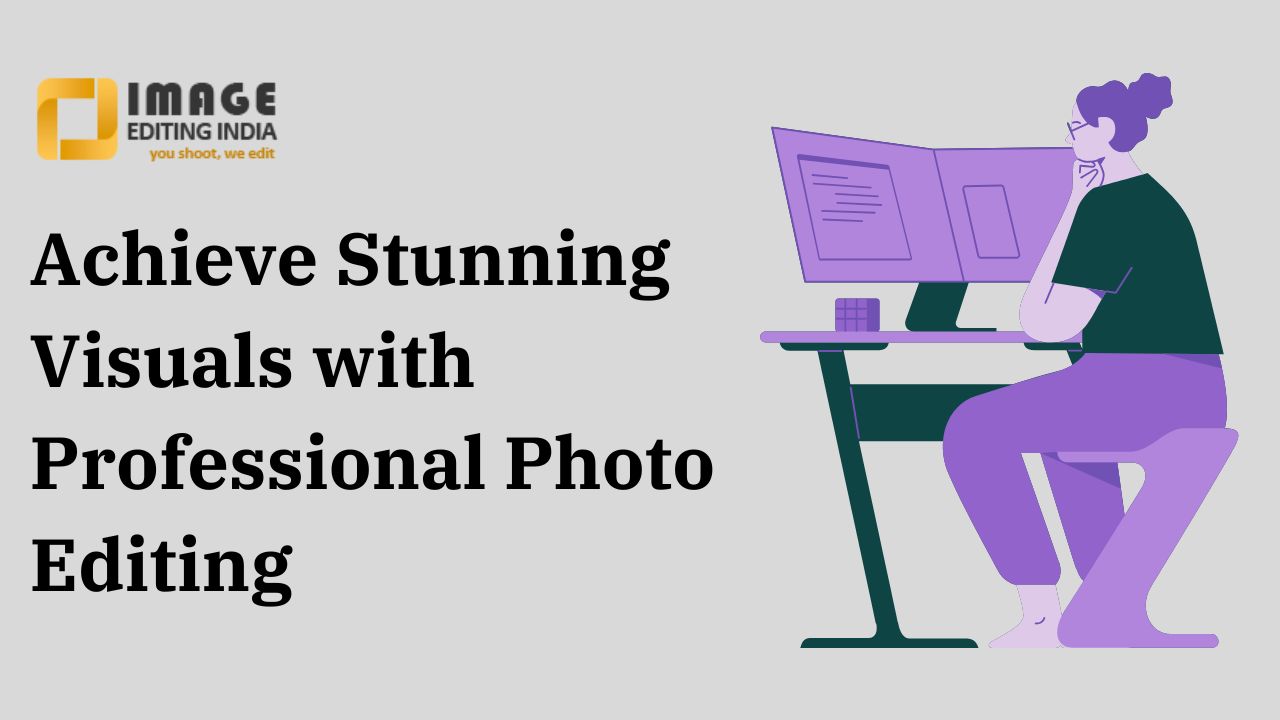Achieve Stunning Visuals with Professional Photo Editing
In today’s visual-driven world, high-quality images are essential for capturing attention and making a strong impression. Whether for marketing materials, social media, e-commerce, or personal branding, professional photo editing transforms ordinary photos into captivating visuals that effectively communicate your message and stand out from the competition. From subtle adjustments to major enhancements, professional editing can elevate the quality of your photos, ensuring they align with your brand’s style and appeal to your audience.
This article explores the benefits, techniques, and applications of professional photo editing to help you achieve stunning visuals that make a lasting impact.
Why Professional Photo Editing is Essential
Professional photo editing goes beyond simple filters or adjustments. It involves skilled techniques to improve the image’s quality, highlight its strengths, and fix any imperfections. Here’s why investing in professional photo editing is beneficial:
- Brand Image: High-quality, well-edited photos reflect positively on your brand, making you appear credible and professional. Consistent and polished images help establish a recognizable brand identity.
- Increased Engagement: Stunning visuals are more likely to capture and retain viewers’ attention, increasing engagement on social media, websites, and other platforms.
- Improved Conversion Rates: For e-commerce and marketing, well-edited photos can increase conversions by making products or services appear more appealing and trustworthy.
- Emotional Impact: Carefully edited photos can evoke emotions, connect with viewers on a deeper level, and effectively communicate your message.
- Versatility: Professional editing ensures that photos look great across various platforms, from digital screens to print, enhancing their versatility for different marketing needs.
Popular Techniques in Professional Photo Editing
Professional photo editing encompasses a range of techniques, each designed to enhance specific aspects of the image. Here are some commonly used techniques to achieve high-quality results:
- Color Correction and Grading: Adjusting colors, contrast, and brightness ensures that images are visually appealing and consistent with the brand’s style. Color grading can also add specific moods to photos, whether warm and inviting or cool and sophisticated.
- Background Removal and Replacement: Removing or replacing backgrounds is crucial for product photos, portraits, and creative compositions. Clean backgrounds make products stand out and allow for more versatile use of images in various settings.
- Blemish Removal and Skin Smoothing: In portrait photography, blemish removal and skin smoothing create a polished and natural look. This technique helps remove imperfections while preserving the subject’s authenticity.
- Sharpening and Detail Enhancement: Adding sharpness and enhancing details make the image look crisp and high-quality, which is particularly important for product photography and close-up shots.
- Object Removal: Removing unwanted objects or distractions helps draw attention to the main subject, creating a cleaner and more focused image. This technique is useful for both real estate and commercial photography.
- Light and Shadow Adjustments: Controlling light and shadow adds depth to images, creating a more dynamic look. By highlighting key areas and downplaying others, editors can guide the viewer’s focus within the image.
Applications of Professional Photo Editing
Professional photo editing is valuable across many industries, each with unique requirements and goals. Here’s a look at how it benefits various fields:
- E-commerce and Product Photography: In e-commerce, high-quality product images are essential for conversions. Professional editing helps create sharp, clear, and enticing photos that showcase the product’s details, features, and colors accurately. Background removal, color correction, and shadow adjustments are commonly used techniques.
- Real Estate and Interior Design: Real estate photos must make spaces look inviting, bright, and spacious. Editing techniques such as HDR blending, color correction, and sky replacement are often used to enhance property images, making listings more appealing.
- Portrait and Fashion Photography: In portrait and fashion photography, editing helps create flawless yet natural-looking images. Techniques like skin retouching, color grading, and background enhancement bring out the best in each subject.
- Social Media and Content Creation: For influencers and brands, social media content must be visually compelling to attract followers and engagement. Editing adds a professional touch, creating cohesive and attractive visuals that reflect the brand’s aesthetic.
- Marketing and Advertising: Edited images are essential for marketing materials, from brochures and websites to digital ads. Professional editing enhances the visual quality, creating an impactful look that resonates with the audience and strengthens brand identity.
- Event and Wedding Photography: Event photos capture special moments, and editing ensures that these memories look their best. Adjusting lighting, removing distractions, and enhancing colors create memorable images that clients cherish.
Tips for Achieving Professional-Quality Edits
While photo editing software has made it easier to edit images, achieving professional-quality results requires a blend of skill, experience, and attention to detail. Here are some tips for effective photo editing:
- Start with High-Quality Photos: Even the best editing can only do so much with a low-quality image. Start with well-lit, high-resolution photos for optimal results.
- Maintain a Natural Look: Over-editing can make photos look artificial. Aim for subtle enhancements that improve the image without making it look overly manipulated.
- Use Non-Destructive Editing Techniques: Tools like Adobe Photoshop and Lightroom allow for non-destructive editing, meaning changes don’t permanently alter the original image. This approach lets you make adjustments without losing the original quality.
- Invest in Good Software: Professional-grade software like Adobe Photoshop, Lightroom, and Capture One offers powerful editing tools and precise control over the image.
- Keep a Consistent Style: Consistency is essential, especially for brands. Develop a specific editing style that aligns with your brand’s aesthetics, ensuring a cohesive look across all images.
- Use Layers and Masks: Layers and masks in software like Photoshop allow for precise control over specific areas of the image, enabling you to make targeted adjustments without affecting the entire photo.
- Regularly Update Skills: Photo editing techniques evolve with technology, so it’s essential to stay updated on new tools, trends, and skills to keep your work fresh and professional.
Choosing a Professional Photo Editing Service
Outsourcing your photo editing to a professional service can save time and ensure top-quality results. Here’s what to consider when choosing a professional photo editing service:
- Portfolio and Style: Review the service’s portfolio to understand its editing style and quality. Ensure it aligns with your needs and aesthetic preferences.
- Turnaround Time: If you need photos edited quickly for marketing campaigns or social media, choose a service with a quick and reliable turnaround.
- Customer Support: Reliable communication and customer support are essential, especially if you need adjustments or specific edits.
- Pricing: Compare pricing and packages to ensure the service fits within your budget. Many services offer discounts for bulk projects, which can be beneficial for ongoing needs.
- Quality Assurance: A reputable service will offer quality assurance to ensure each photo meets your expectations before delivery.
The Impact of Professional Photo Editing on Branding
Visual consistency is key to creating a recognizable and memorable brand. Professional photo editing contributes to branding by:
- Establishing a Cohesive Look: Consistent editing across all images reinforces brand identity and makes marketing materials more recognizable.
- Enhancing Visual Appeal: High-quality visuals attract attention and leave a positive impression, which is crucial for building brand credibility.
- Creating a Memorable Brand Experience: Professionally edited photos resonate with viewers, creating a memorable experience that helps establish brand loyalty.
- Supporting Brand Storytelling: Through color grading, composition, and other editing techniques, professional photos can tell a brand’s story and connect with the audience on an emotional level.
Conclusion: Achieve Stunning Visuals with Professional Photo Editing
Ìt is a powerful tool that transforms images into captivating visuals, helping brands and individuals stand out in a competitive visual landscape. With techniques like color correction, background removal, blemish retouching, and sharpening, professional editing enhances image quality, creating polished photos that resonate with audiences.
Whether you’re an e-commerce store owner, real estate agent, influencer, or creative professional, investing in Professional Photo Editing Service can elevate your visuals, increase engagement, and strengthen your brand identity. By utilizing advanced editing tools and techniques, you can achieve stunning results that leave a lasting impression, helping you communicate your message and make an impact.














Post Comment